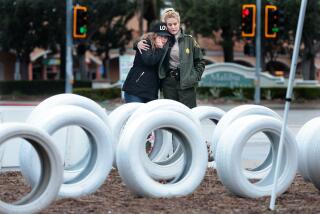The Guardian Angels Who Watch the Road
- Share via
He thought he was being so careful: Braking well before the stop sign. Bouncing to a complete halt. Swiveling his head to the left and the right. Then, and only then, easing into the intersection.
For a guy who had been slapped with a traffic violation for a rolling “California stop” just a few weeks before, 39-year-old Al Luna figured he was playing it pretty darn safe.
But then came a voice from the passenger’s seat.
“Do you know the minimum amount of time you have to stay stopped at a stop sign?” driving instructor Gary Camponi asked. Luna had to admit he had no idea. Three seconds, it turned out, was the appropriate answer. To show Luna just how interminable three seconds could be, Camponi counted them out on his fingers. One, one thousand. Two, one thousand. Three, one thousand. Go.
Luna sighed and nosed his 1986 Toyota Forerunner ahead.
But he later conceded that the lesson had been valuable. Valuable, at least, compared to the alternative: eight hours of yawn-inducing classroom instruction. “It’s better than sitting in traffic school,” he said.
*
Building on the philosophy that hands-on experience is more useful than textbook explanations, a nonprofit group called Road Angels has developed an on-the-road course that traffic violators can attend instead of traditional classroom instruction. The course--called the Road Angels’ Defensive Driving and Community Service Program--is now available only to violators sentenced through the East Los Angeles Municipal Court. Yet founder Eric Oster hopes to expand it soon throughout the county.
“The idea is to put the concept of backseat driving to use,” Oster told a group of five students at a recent Saturday session. “Normally, it’s not cool when someone tells you what you should be doing on the road. But here, it’s not only cool, it’s required. Maybe we’ll bruise some egos, but we think everyone can use criticism, especially if it’s constructive.”
The Road Angels course relies on teamwork and peer pressure to make violators realize the errors of their ways.
Trained instructors ride shotgun next to one student, while two or three other students pile into the back (all, of course, buckled up in seat belts). The observers critique the driver’s performance out loud, pointing out sloppy turns or questioning the rationale behind an abrupt lane change.
For the community service portion of the course, all students are supposed to keep an eye out for suspicious characters or citizens in need of help. Their instructor can radio a dispatcher if they spot anything out of line.
After about an hour of cruising freeways and surface streets, the crew returns to the Road Angels’ Sunset Boulevard office to switch cars and let another student take the wheel.
“We’re going on the premise that traffic school doesn’t work,” instructor Camponi explained. “If they tell you that you’re supposed to come to a complete stop at a stop sign or that you’re not supposed to do 54 [mph] in a 35-mile-per-hour zone, well, obviously these are things you already know. Our idea is to put you in your car with someone who can take a good hard look at your driving habits and remind you that you have a responsibility not only to yourself, but to the other people on the road with you.”
*
Such lofty ideals sound great. But they’re not the real reason people come to the Road Angels. At $39 for four hours, the defensive driving class is shorter and cheaper than most traffic schools. And for violators, that is motivation enough to join up. As Luna put it: “I wanted to get this over and done with.”
Once they get on the road with an instructor, however, the students often find themselves having fun--and learning--in spite of themselves.
Cesar Jacobo, who opted for the course after receiving a speeding ticket, wedged himself into the back seat of Luna’s truck on a recent session and immediately got into the Road Angels spirit. He warned Luna to watch out for motorcycles and reminded him to wait three seconds after a red light turned green before zooming into the intersection.
“I don’t think you can get bored driving around,” Jacobo concluded, gazing out the window at the rollicking foot traffic on Melrose. “Not compared to being in a classroom. That’s what really drags.”
More to Read
Go beyond the scoreboard
Get the latest on L.A.'s teams in the daily Sports Report newsletter.
You may occasionally receive promotional content from the Los Angeles Times.






